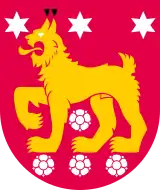Hämeenlinna
Tavastehus | |
|---|---|
City | |
| Hämeenlinnan kaupunki Tavastehus stad City of Hämeenlinna | |
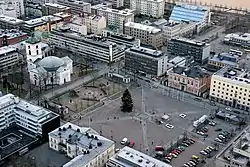 Aerial view of the city centre (and the Market Square) of Hämeenlinna. | |
 Coat of arms | |
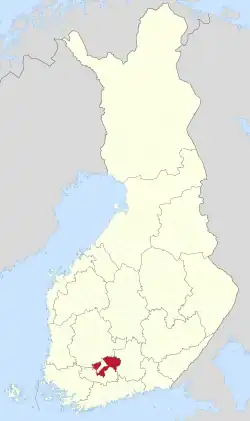 Location of Hämeenlinna in Finland | |
OpenStreetMap Interactive map outlining Hämeenlinna. | |
| Coordinates: 60°59′40″N 24°28′00″E / 60.99444°N 24.46667°E | |
| Country | |
| Region | |
| Sub-region | Hämeenlinna sub-region |
| Charter | 1639 |
| Government | |
| • City manager | Olli-Poika Parviainen |
| Area (2018-01-01)[1] | |
| • Total | 2,031.53 km2 (784.38 sq mi) |
| • Land | 1,785.35 km2 (689.33 sq mi) |
| • Water | 245.79 km2 (94.90 sq mi) |
| • Rank | 34th largest in Finland |
| Population (2023-09-30)[2] | |
| • Total | 68,141 |
| • Rank | 15th largest in Finland |
| • Density | 38.17/km2 (98.9/sq mi) |
| Population by native language | |
| • Finnish | 93.7% (official) |
| • Swedish | 0.4% |
| • Others | 5.9% |
| Population by age | |
| • 0 to 14 | 14.5% |
| • 15 to 64 | 59.3% |
| • 65 or older | 26.2% |
| Time zone | UTC+02:00 (EET) |
| • Summer (DST) | UTC+03:00 (EEST) |
| Website | www |
Hämeenlinna (Finnish: [ˈhæmeːnˌlinːɑ]; Swedish: Tavastehus; Karelian: Hämienlinna; Latin: Tavastum or Croneburgum[5]) is a city and municipality of about 68,000 inhabitants[2] in the heart of the historical province of Tavastia and the modern province of Kanta-Häme in the south of Finland. Hämeenlinna is the oldest inland city of Finland[6] and was one of the most important Finnish cities until the 19th century. It remains an important regional center. The medieval Häme Castle (also Tavastia Castle; Finnish: Hämeen linna) is located in the city.
Hämeenlinna is known as the birthplace of Finnish national composer Jean Sibelius. Today, it belongs to the region of Tavastia Proper (Kanta-Häme), and before 2010 it was the residence city for the Governor of the province of Southern Finland. Nearby cities include the capital Helsinki (98 km or 61 mi), Tampere (73 km or 45 mi) and Lahti (72 km or 45 mi), the regional center of Päijänne Tavastia (Päijät-Häme).
The neighboring municipalities of Hämeenlinna are Akaa, Asikkala, Hattula, Hausjärvi, Hollola, Janakkala, Loppi, Padasjoki, Pälkäne, Tammela, Urjala and Valkeakoski. The former municipalities, Hauho, Kalvola, Lammi, Renko and Tuulos, were consolidated with Hämeenlinna on 1 January 2009;[7] with these municipal associations, the Hattula municipality is almost completely surrounded by Hämeenlinna.
The coat of arms of Hämeenlinna is based on the 17th-century town seal, which in turn refers to the Häme Castle built by the Lake Vanajavesi in the Middle Ages, near which the city was founded. The current coat of arms was designed by Gustaf von Numers on the basis of the old coat of arms, and was confirmed on September 21, 1956.[8][9]
History
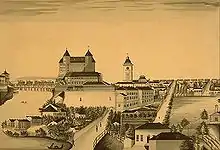
Vanaja is the name of a settlement next to Vanajavesi that had been in existence since the Viking Age. The castle was built in the late 13th century to secure Swedish power in central Finland. A village was established near Häme Castle to provide services and goods to its inhabitants.
The village was granted city rights on January 19, 1639,[10] but Hämeenlinna, which still after that looked more like a rural village, developed very slowly, which was a typical problem for inland cities in Finland compared to the most prosperous coastal cities.[11] In 1777, King Gustav III of Sweden moved it one kilometre (0.6 miles) south to the hill on which it still stands.[11]
The city is known for its schools and academies where many famous Finns have studied.[12] Schools, government and the military have characterised the life of Hämeenlinna throughout history. Finland's first railway line, the Finnish Main Railway (Finnish: Suomen päärata, Swedish: Stambanan), opened between Hämeenlinna and Helsinki on March 17, 1862.[13][14][15] The current Hämeenlinna railway station (Rautatieasema in Finnish) was built in 1921.
During the Finnish Civil War in 1918, Hämeenlinna was initially in the area controlled by the Reds, but the Whites captured the city with the help of the Germans in the Battle of Hämeenlinna.[16] After the war, the Hämeenlinna prison camp established for red prisoners operated in the Poltinaho barracks area, and it was known as one of the most notorious high-discipline camps in the history of the Civil War, where female prisoners were also kept.[17] By mid-September, over 2,000 Red prisoners died in the prison camp,[18] mainly for communicable diseases such as smallpox, scarlet fever, typhus and Spanish flu.[19]
Geography
There are a total of 339 lakes in whole or in part in the area of the city of Hämeenlinna. The largest of them are Lake Vanajavesi, Lake Kukkia and Lake Kuohijärvi.[20] The main features of the Hämeenlinna landscape are the Häme Lake Plateau, the Vanajavesi Valley and the Kanta-Häme Grove Center. In many places, the landscapes are marked by the prosperous Tavastian agricultural culture.[21][22]
The city has several nature reserves, the largest of which are located in the popular recreation areas of Aulanko and Ahvenisto on the outskirts of the city. In total, there are 31 Natura 2000 areas in the city of Hämeenlinna.[23] In addition, Hämeenlinna has Finland's first national urban park, established in 2001.[24]
Climate
| Climate data for Hämeenlinna Lammi Pappila (1991–2020 normals, extremes 1963–present) | |||||||||||||
|---|---|---|---|---|---|---|---|---|---|---|---|---|---|
| Month | Jan | Feb | Mar | Apr | May | Jun | Jul | Aug | Sep | Oct | Nov | Dec | Year |
| Record high °C (°F) | 7.7 (45.9) |
7.8 (46.0) |
15.9 (60.6) |
23.7 (74.7) |
29.0 (84.2) |
31.8 (89.2) |
33.2 (91.8) |
32.6 (90.7) |
25.9 (78.6) |
19.2 (66.6) |
12.8 (55.0) |
10.2 (50.4) |
33.2 (91.8) |
| Mean daily maximum °C (°F) | −3.1 (26.4) |
−3.0 (26.6) |
1.6 (34.9) |
8.5 (47.3) |
15.5 (59.9) |
19.5 (67.1) |
22.0 (71.6) |
20.5 (68.9) |
14.8 (58.6) |
7.5 (45.5) |
2.1 (35.8) |
−1.0 (30.2) |
8.7 (47.7) |
| Daily mean °C (°F) | −5.8 (21.6) |
−6.3 (20.7) |
−2.5 (27.5) |
3.5 (38.3) |
9.8 (49.6) |
14.2 (57.6) |
16.9 (62.4) |
15.1 (59.2) |
10.2 (50.4) |
4.5 (40.1) |
0.2 (32.4) |
−3.3 (26.1) |
4.7 (40.5) |
| Mean daily minimum °C (°F) | −8.6 (16.5) |
−9.5 (14.9) |
−6.2 (20.8) |
−1.0 (30.2) |
3.9 (39.0) |
8.8 (47.8) |
11.6 (52.9) |
10.5 (50.9) |
6.5 (43.7) |
1.9 (35.4) |
−1.9 (28.6) |
−5.6 (21.9) |
0.9 (33.6) |
| Record low °C (°F) | −37.4 (−35.3) |
−36.2 (−33.2) |
−28.5 (−19.3) |
−15.9 (3.4) |
−10.7 (12.7) |
−2.0 (28.4) |
0.9 (33.6) |
−0.3 (31.5) |
−6.0 (21.2) |
−15.7 (3.7) |
−22.1 (−7.8) |
−34.2 (−29.6) |
−37.4 (−35.3) |
| Average precipitation mm (inches) | 49 (1.9) |
37 (1.5) |
34 (1.3) |
32 (1.3) |
41 (1.6) |
64 (2.5) |
79 (3.1) |
72 (2.8) |
54 (2.1) |
66 (2.6) |
58 (2.3) |
53 (2.1) |
639 (25.2) |
| Average precipitation days | 12 | 9 | 8 | 7 | 8 | 10 | 11 | 10 | 9 | 11 | 11 | 12 | 118 |
| Source 1: FMI climatological normals for Finland 1991–2020[25] | |||||||||||||
| Source 2: Record highs and lows 1963–present[26] | |||||||||||||
Cityscape
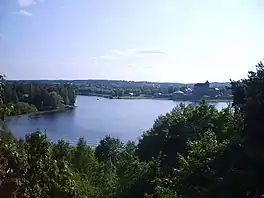
The center of Hämeenlinna is located on the Saarinen Hill on the shores of Lake Vanajavesi, and is bordered on the west by Highway 3 (E12), while Highway 10 bypasses the city to the south and east. The street network in the center is based on a grid pattern drawn up by C. L. Engel in 1832 with the Market Square as its center.[27] On the edge of the market square are the town hall, Hämeenlinna Church and the Häme County Government House.[28] The city center is divided into four districts, which are Linnanniemi, Koilliskulma, Hämeensaari and Saaristenmäki. Raatihuoneenkatu, which has been partially transformed into a pedestrian street, is the most significant shopping street in the city center; for example, at the western end of the street, the Goodman Shopping Center was completed in October 2014.[29]
There are plenty of buildings of different styles in the city center, and in proportion to the city's population, it is quite large and densely built. The most significant expansion direction in the city center in the 2010s has been the Keinusaari district on the other side of Lake Vanajavesi, where, for example, the city's railway station is located. Supplementary construction has also been carried out in the city center on an ongoing basis. The center of Hämeenlinna has been ridiculed as the "Finland's largest lit cemetery".[30]
Demographics
Population
The city of Hämeenlinna has 68,141 inhabitants, making it the 15th most populous municipality in Finland. The Hämeenlinna region has a population of 93,592. In Hämeenlinna, 6.0% of the population has a foreign background, which is below the national average.[31]
| Year | Population |
|---|---|
| 1990 | 61,222 |
| 1995 | 62,080 |
| 2000 | 63,033 |
| 2005 | 64,271 |
| 2010 | 66,829 |
| 2015 | 68,011 |
| 2020 | 67,848 |
Languages
Population by mother tongue (2022)[31]
Hämeenlinna is a monolingual Finnish-speaking municipality. The majority of the population – 63,759 people or 93.7% – speak Finnish as their first language. There are 254 Swedish speakers in Hämeenlinna, or 0.4% of the population.[31] 5.9% of the population of Hämeenlinna have a mother tongue other than Finnish or Swedish.[31] As English and Swedish are compulsory school subjects, functional bilingualism or trilingualism acquired through language studies is not uncommon.
At least 40 different languages are spoken in Hämeenlinna. The most common foreign languages are Estonian (0.7%), Russian (0.7%), Arabic (0.7%) and Farsi (0.5%).[31]
Immigration
| Population by country of birth (2022)[31] | ||
| Nationality | Population | % |
|---|---|---|
| 64,094 | 94.2 | |
| 424 | 0.6 | |
| 380 | 0.6 | |
| 277 | 0.4 | |
| 207 | 0.3 | |
| 183 | 0.3 | |
| 177 | 0.3 | |
| 160 | 0.2 | |
| 157 | 0.2 | |
| 111 | 0.2 | |
| 110 | 0.2 | |
| Other | 1,571 | 2.3 |
In 2022, there were 4,056 persons with a migrant background living in Hämeenlinna, or 6.0% of the population.[note 1] The number of residents who were born abroad was 3,949, or 5.8% of the population. The number of persons with foreign citizenship living in Hämeenlinna was 2,764.[33] Most foreign-born citizens came from the Estonia, former Soviet Union, Iraq and Poland.[31]
The relative share of immigrants in Hämeenlinna's population is below to the national average. However, the city's new residents are increasingly of foreign origin. This will increase the proportion of foreign residents in the coming years.
Religion
In 2022, the Evangelical Lutheran Church was the largest religious group with 69.3% of the population of Hämeenlinna. Other religious groups accounted for 2.5% of the population. 28.2% of the population had no religious affiliation.[31]
Economy
The economic structure of Hämeenlinna is close to the national average. In 2015, there were 28,270 jobs in the city. Of these, 75% were in the service sector, 3% in primary production (agriculture, forestry and fisheries) and 21% in processing. The share of the unemployed was 13,6%.[34]
Largest employers (by number of employees) [35]
- City of Hämeenlinna: 2,490
- State of Finland: 2,480
- Kanta-Häme Hospital District: 1,460
- Ruukki (Rautaruukki Oyj): 1,030
- Huhtamäki Oyj: 700
- HAMK University of Applied Sciences (an institution offering tertiary degree education): 510
- Kansanterveystyön ky: 490
- Patria Vehicles Oy: 430
- Konecranes Standard Lifting Oy: 330
- Koulutuskeskus Tavastia: 270
- Aina Group Oyj: 250
- Lindström Oy: 175
Education
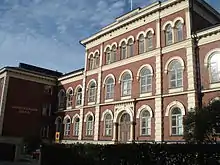
Hämeenlinna is home to HAMK Häme University of Applied Sciences' headquarters.[36] Founded in 1873, Hämeenlinna Lyceum has many cultural influencers. The school is one of the most famous educational institutions in Finland, as many well-known Finns have graduated from the institution; examples include master composer Jean Sibelius and president J. K. Paasikivi.[12] Hämeenlinna Lyceum has a middle school (grades 7–9) and a high school. Another of the high schools in Hämeenlinna's inner city is Kauriala High School. Hämeenlinna's Lyceum and Kauriala High School were to be combined in the fall of 2018 to form a large high school with more than a thousand students on the Hattelmala campus of the Tavastia Education Consortium.[37] However, the city council decided to cancel the high school project in the spring of 2018, and the high schools will continue to be separate.[38]
Culture
Food
In the 1980s, the following dishes were named Hämeenlinna's traditional cuisine: as a daily meal, smoked ham and sourdough; as a festive meal, the herring wrapped in rye dough, i.e. "fish bread", buttermilk and beer, and the riistansylttääjän lintupaisti, which means pheasant stuffed almonds with potato and apple slices.[39]
Sport
- Elite level ice hockey teams HPK of the SM-liiga and HPK Kiekkonaiset of the Naisten Liiga
- Football teams FC Hämeenlinna and the men's representative team of Hämeenlinnan Härmä, which play in the third-tier Kakkonen, and the women's representative team of Hämeenlinnan Härmä of the second-tier Naisten Ykkönen
- The city hosted the modern pentathlon competition for the 1952 Summer Olympics in Helsinki.
- Hämeenlinna hosted the first round of the Underwater Rugby Euroleague in October 2012 and again in 2015.
- The Ahvenisto Race Circuit, opened in 1967, hosts many motorsport happenings. Track has an FIA Grade 4 license.
- Steelers Sailbandy(Floorball) Club which play in the F-liiga.
Notable natives or residents

- Jouko Ahola (strongman/actor)
- Antony Hämäläinen (vocalist)
- Eino Leino (poet)
- Marko Mäkilaakso (music video and film director)
- Antti Miettinen (NHL player); won a bronze medal with Finland in the 2010 Vancouver Olympics
- Victorine Nordenswan (painter)
- J. K. Paasikivi (7th President of Finland)
- Kimi Räikkönen (Formula One driver) and Jenni Dahlman (married in 2004 in Hämeenlinna)
- Juuse Saros (NHL goaltender)
- Jean Sibelius (composer)
- Turisas (metal band)
International relations
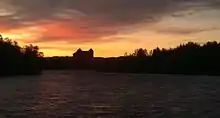
Twin towns – Sister cities
Hämeenlinna is twinned with:[40]
|
See also
Notes
References
- ↑ "Area of Finnish Municipalities 1.1.2018" (PDF). National Land Survey of Finland. Retrieved 30 January 2018.
- 1 2 "Preliminary population statistics 2023, September". StatFin. Statistics Finland. Retrieved 26 October 2023.
- ↑ "Demographic Structure by area as of 31 December 2022". Statistics Finland's PX-Web databases. Statistics Finland. Retrieved 6 September 2023.
- ↑ "Population according to age (1-year) and sex by area and the regional division of each statistical reference year, 2003–2020". StatFin. Statistics Finland. Retrieved 2 May 2021.
- ↑ J. G. Th. Graesse: Orbis Latinus (Dresdae: Schönfeld, 1861; 1909. Brunsvici, 1972, 3 voll.) (in Latin)
- ↑ "Juhlavuodet" (in Finnish). City of Hämeenlinna. 9 February 2017. Retrieved 17 September 2021.
- ↑ "Valtioneuvoston päätös Hauhon kunnan, Kalvolan kunnan, Lammin kunnan, Rengon kunnan ja Tuuloksen kunnan liittämisestä Hämeenlinnan kaupunkiin sekä eräiden alueiden siirtämisestä Hattulan kunnasta Hämeenlinnan kaupunkiin" (in Finnish). Finlex. 3 July 2008. Retrieved 2 September 2021.
- ↑ Hagerlund, Tony (12 January 2010). "Vaakunat: Haapajärvi – Hämeenlinna" (in Finnish). Suomen Kuntaliitto. Retrieved 17 September 2021.
- ↑ Бойко Дм. А. Геральдика Великого Княжества Финляндского. – Запорожье, 2013. (in Russian)
- ↑ HÄMEENLINNA – TAVASTEHUS Kaupunkiarkeologinen inventointi (in Finnish)
- 1 2 Karpiola, Saila (9 October 2022). "Maanalaista kaupunkia ei ole koskaan tutkittu, mutta maan alla piilotteleva vanha Hämeenlinna voi vielä yllättää löytäjänsä iloisesti". Hämeen Sanomat (in Finnish). Retrieved 10 October 2022.
- 1 2 "Kuka kävi Lyskan ja missä?". Hämeen Sanomat (in Finnish). 14 June 2015. Retrieved 10 October 2022.
- ↑ "Ensimmäinen Juna Hämeenlinnaan". Hämäläinen (in Finnish). 31 January 1862. Retrieved 18 January 2021.
- ↑ Neil Kent: Helsinki: A Cultural History, p. 18. Interlink Books, 2014. ISBN 978-1566565448.
- ↑ "Tulihevonen saapui ensi kerran Hämeenlinnaan 150 vuotta sitten" [The "fire horse" arrived first time in Hämeenlinna 150 years ago]. Yle Häme (in Finnish). Yle. 31 January 2012. Retrieved 29 September 2021.
- ↑ Kuoleman kentiltä: muistojulkaisu vuoden 1918 ajoilta (in Finnish). Hämeenlinna: Hämeen eteläinen sos.-dem. piiritoimikunta. 1924. pp. 75–78, 88–92.
- ↑ "Hämeenlinnan pahamaineisen punavankileirin vaietuista naisvangeista kirja". Yle (in Finnish). 19 April 2011. Retrieved 9 August 2023.
- ↑ "Punaisten joukkohautojen muistokivet" (in Finnish). City of Hämeenlinna. 27 January 2014. Retrieved 9 August 2023.
- ↑ Peltonen, Ari-Pekka (2013). "Espanjantautia Hämeenlinnassa – Vuosien 1918–1920 influenssapandemia Hämeenlinnan kaupungissa" (PDF) (in Finnish). Department of History and Geography; University of Eastern Finland. Retrieved 9 August 2023.
- ↑ "Hämeenlinna". Järviwiki (in Finnish). Retrieved 4 March 2021.
- ↑ Jutila, Heli; Harju, Hannu (2005). "Kalvolan luonto-opas" (PDF). Hämeenlinnan seudun kansanterveystyön kuntayhtymän ympäristöosasto, NAPA-projekti (in Finnish). Retrieved 4 March 2021.
- ↑ Jutila, Heli; Harju, Hannu (2004). "Rengon luonto-opas" (PDF). Hämeenlinnan seudun kansanterveystyön kuntayhtymän ympäristöosasto, NAPA-projekti (in Finnish). Retrieved 4 March 2021.
- ↑ "Tutustu Natura 2000 -kohteisiin kunnittain". ymparisto.fi (in Finnish). Retrieved 9 August 2023.
- ↑ "Housing and environment". City of Hämeenlinna. Retrieved 9 August 2023.
- ↑ "FMI normals 1991–2020" (PDF). Finnish Meteorological Institute. Retrieved 17 March 2023.
- ↑ "FMI open data". FMI. Retrieved 17 March 2023.
- ↑ Rakennushistoriaselvitys: Lääninhallituksen rakennukset – Hämeenlinna, 2018 – Arkkitehtitoimisto ark-byroo (in Finnish)
- ↑ Y. S. Koskimies (1970). Hämeenlinna (in Finnish). Hämeenlinna: Karisto. p. 7.
- ↑ Hämeenlinnan kaupungin karttapalvelu (in Finnish)
- ↑ Suomen suurin valaistu hautausmaa Archived 2 April 2015 at the Wayback Machine – Hämeen Sanomat (in Finnish)
- 1 2 3 4 5 6 7 8 9 "Number of foreign-language speakers grew by nearly 38,000 persons". Statistics Finland. 31 May 2023. Retrieved 12 September 2023.
- ↑ "Persons with foreign background". Statistics Finland. Retrieved 18 September 2023.
- ↑ "Population structure 2000-2022, urban-rural classification". Statistics Finland. 26 May 2023. Retrieved 12 September 2023.
- ↑ "Kuntien avainluvut". Tilastokeskus (in Finnish). Retrieved 19 May 2021.
- ↑ "Taskutietoa Hämeenlinnasta – KESKUSHALLINTO – Hämeenlinnan kaupunki". Archived from the original on 10 December 2006. Retrieved 13 November 2006., Taskutietoa Hämeenlinnasta, a factbook published by the city of Hämeenlinna (PDF download, in Finnish)
- ↑ Häme University of Applied Sciences (HAMK)
- ↑ Hämeenlinnan suurlukio Hattelmalan kampukselle – Yle (in Finnish)
- ↑ Kahden lukion malli voitti kaupunginhallituksessa – Hämeenlinnan Kaupunkiuutiset (in Finnish)
- ↑ Kolmonen, Jaakko 1988. Kotomaamme ruoka-aitta: Suomen, Karjalan ja Petsamon pitäjäruoat, s. 67. Helsinki: Patakolmonen Ky. (in Finnish)
- ↑ "Ystävyyskaupungit" (in Finnish). City of Hämeenlinna. Retrieved 22 August 2019.
External links
 Hämeenlinna travel guide from Wikivoyage
Hämeenlinna travel guide from Wikivoyage- City of Hämeenlinna – Official Site (in English)
- 1952 Summer Olympics official report (pp. 60–62)
- Häme Castle

